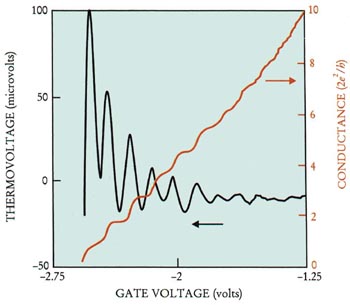The conductance is the coefficient of proportionality between current and voltage. The additional presence of a small temperature differenceacross the point contact gives rise to a matrix of coefficients:

The thermal conductance K relates heat current to temperature difference. The thermo-electric cross-phenomena are described by coefficients L and L'. As first deduced by Lord Kelvin, time-reversal symmetry requires that L'=-LT (at a temperature T).The two new transport coefficients K and L can be expressed in terms of the transmission probabilities, just like the electrical conductance G. (See sidebar.) Approximately,
and
, where
is the total transmission probability at the Fermi energy
. (The proportionality of K to t, and hence to G, is the Wiedemann-Franz law of solid-state physics.) The stepwise energy dependence of the transmission probability through a quantum point contact implies two types of quantum-size effects: steps in K and peaks in L. Both effects have been observed by Laurens Molenkamp and collaborators from Philips [19].
The thermal conductance K of a quantum point contact exhibits steps when the gate voltage is varied, aligned with the steps in the electrical conductance. Each step signals the appearance of a new mode at the Fermi level which can propagate through the constriction. A step in the transmission probability leads to a peak in the thermo-electric coefficient L. Pavel Streda [18] (Prague) has calculated that, at zero temperature, the height of the peaks in L is approximately k/e times the conductance quantum e2/h. The unit
is the entropy production per Coulomb of charge transferred through the point contact, or 1/e times the entropy carried by a single conduction electron, which is on the order of Boltzmann's constant k.

Figure 5. Thermopower oscillations in a quantum point contact. The peaks in the thermovoltage (proportional to the thermopower) coincide with the steps in the conductance. (Adapted from ref. [20].)
In figure 5 we show measurements of the thermopower S=-L/G of a quantum point contact [20]. (The thermopower is proportional to the voltage produced by a temperature difference for zero electrical current.) The coincidence of peaks in the thermopower with steps in the conductance (measured for the same point contact) is clearly visible. Joule heating was used to create a temperature difference across the point contact in this work. Local heating by means of a focused beam of far-infrared radiation has been used in a more recent experiment [21].